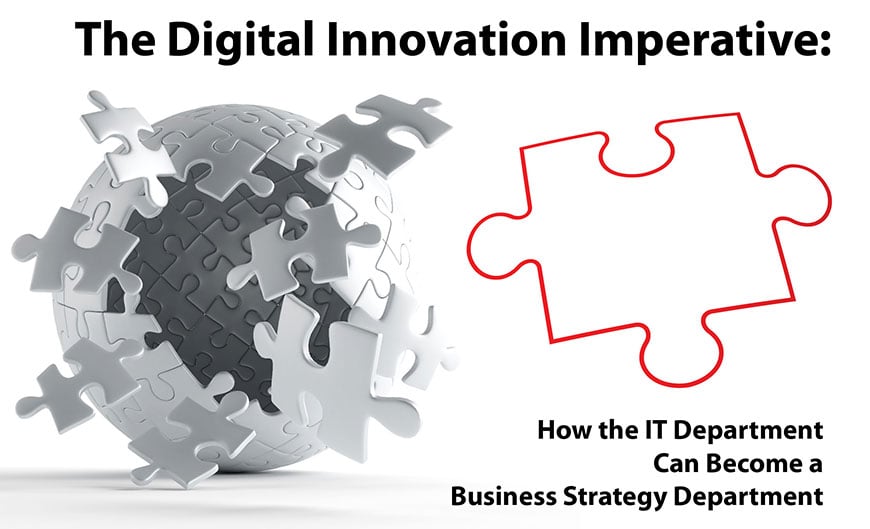The Digital Innovation Imperative: Transforming Your IT Department


Every industry in our economy will see one-third of its top 20 companies seriously disrupted by new entrants, and transformed incumbents who will deliver new offerings using technology to become digital innovation companies.
At least that’s what IDC predicts in a report according to this CIO.com article.
Companies are adopting innovative technologies to either stay ahead of the competition, enter new markets, or knock traditional business leaders off their perch.
What’s going on?
IDC calls it the Third Platform. Others call it the SMAC Stack. We’ve said that Every Business is Digital. Whatever you decide to call it, you know that a sea change is happening to business over the next 5-10 years at the intersection of business strategy and technology.
We wanted to talk about digital innovation (and we’re holding an invitation-only conference about it in Cancun), but we want to approach the topic differently.
Instead of looking at the theoretical underpinnings of digital innovation, we wanted to take a practical approach to help you become a digital innovation company, and share best practices our own consultants would walk you through when planning your innovation strategy.
1. Set Your Digital Business Goals
Gather all your business stake-holders through a series of internal brainstorming and planning sessions to map out your new digital direction. This process is not the time to be formal or realistic. Don’t limit yourself. This is your chance to really think creatively about how you’d like to transform your business with technology.
- Are you an airline? Then you could become an ecommerce company that just happens to own airplanes, and sells vacation and business travel packages.
- Are you a cement and concrete company? Then you could leverage real-time analytics, mapping applications and logistics to deliver concrete more quickly and efficiently while operating fewer cement mixers.
- Are you a healthcare provider? You could become a health information provider, delivering timely and relevant health information to patients’ mobile devices and encourage preventive care habits while driving patient loyalty.
What new business models can your company create using technology?
2. Perform an Internal Assessment: People, Technology Processes.
Now it’s time to come down from the stratosphere and face reality. Where are your strengths? What are your weaknesses? How far do you really have to go to get to your ideal situation?
To perform an assessment, you should cover these three areas:
- Discovery. With your goals clearly in mind, look at your current human resources, your available budget to fund innovation, your services portfolio and support processes. Look at your current technology infrastructure (architecture and source code) and processes.
- Diagnostic. After your discovery you’ll be able to identify current opportunity areas: technology, people, process and information.
- Roadmap. After your internal discovery, the diagnostic analysis you performed, you can map out the path to get to innovation: what technology do you need to acquire and/or build? What processes you should establish? What about your security plan? Establish your new operating process, your monitored metrics, and your governance model.
You could do this internally, but you’ll get much better results hiring a third party to perform this task for you (you could even go through our complimentary pre-assessment to get the process started).
3. Implement Your Digital Innovation Strategy
Implementing your shiny new digital business model and technology is very exciting, but before charging forward please proceed with caution.
- Your Legacy “Girders”. Building mobile and web-based apps is fun and easy, but if you’re exposing legacy data be very careful. Your company’s lifeblood is in your mainframe servers, and building a services-oriented architecture to expose this data is complicated.
- Institute an Identity and Access Governance Process. Some of the recent embarrassing and costly data breaches were largely due to human error – or rather the lack of proper identity and access governance systems. Have you de-provisioned contractors who should no longer have access to your internal systems? Do you have an access management process for consumer-facing applications (also known as Identity Relationship Management)?
- Outsource Carefully. Outsourcing development to create the new applications you need for your innovation plan is a great idea, but not all outsourcing organizations were made the same. Innovation is a very collaborative process. Outsource to lower costs, but more importantly because you might find efficiencies in process and productivity with an outsourcing partner. Look for firms who are flexible and resourceful, who won’t rest until they make it work. Look for firms who use agile development methods. Look for firms who can collaborate frequently with your stake-holders, including occasional on-site visits.
- Make Your Process Agile. Whether you end up outsourcing your digital innovation project or doing it in-house, it’s important to adopt the “early and often” release advantages of agile development. Your innovation plan will change. New market opportunities and technologies, as well as releasing your code early into production, will see to that.
Conclusion
Your road to becoming new, transformed, digital enterprise is ultimately a very unique, personal experience. There are no cookie-cutter solutions.
But there are processes to ensure success and make your dreams of becoming a digital innovator a profitable reality.
And after your brainstorming, goal-setting, internal assessment, roadmap creation and implementation steps, is your IT department ready for the fast-growth that’s sure to come?
In our next post we’ll show you how to keep up with your company’s growth, if and when you hit pay dirt.



.jpg?width=352&name=POST_3_Stages_of_IT_Innovation-03_(1).jpg)